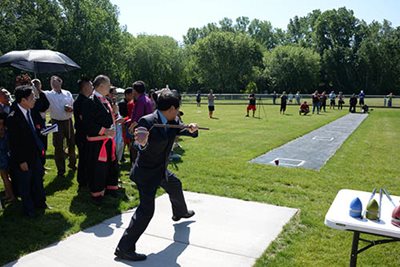Visits to regional parks in the seven-county metro area are at an all-time high. But Met Council research has shown that not all residents visit the regional parks and trails system at the same rates. Residents of color, people living with disabilities, and new Americans are less likely to use the regional parks system, particularly regional trails, than are white residents and people not living with disabilities.
 Council policy makers, however, want to make sure that residents of all ages, abilities, incomes, ethnicities, cultures, and national origins can enjoy the region’s abundance of regional parks and trails. The Council has policies in place to promote park use among residents who are underrepresented. But now it has another tool.
Council policy makers, however, want to make sure that residents of all ages, abilities, incomes, ethnicities, cultures, and national origins can enjoy the region’s abundance of regional parks and trails. The Council has policies in place to promote park use among residents who are underrepresented. But now it has another tool.
On June 26, the Council approved a competitive grant program, in which the 10 regional park agencies can apply for funds for capital investments that promote more inclusive park use. The agencies are the cities, counties and special districts that operate regional parks and trails, which include the Minneapolis Chain of Lakes and Como Park in Saint Paul.
Equity is a Council goal and value
“Equity means access to opportunity,” said Council Chair Nora Slawik. “And this Council is very much behind equity as a regional goal and regional value.
“The Council works to advance equity in the region in many ways, and promoting parks use among all communities is just one,” she said. “An important one, because parks encourage exercise, recreation, community and respite — important to all of us as individuals and as a broader society.”
Some of the barriers to park access: lack of awareness of the regional parks, limited transportation options to get to the parks, and lack of park features that are multicultural, like gathering spaces that accommodate larger groups.
“We have fairly limited funding through this pilot program, at least initially,” said Emmett Mullin, the Council’s manager of Regional Parks & Natural Resources.
“However, in early 2020 we will evaluate the successes and achievements of this initial funding to promote equitable parks use,” he said. “And, we will adapt the program based on what we learn. In the future, we hope to expand the program and available resources to help reduce and eliminate barriers to regional park visits.”
 Regional Parks System Competitive Equity Grant Program
Regional Parks System Competitive Equity Grant Program
-
Purpose: Promote equitable use of regional parks
-
Eligible applicants: 10 regional park implementing agencies
-
Available funds: $300,000, with a $30,000 grant minimum, and $200,000 grant maximum
-
Application review team: Three members of the Metropolitan Parks and Open Space Commission; two members of the Council’s Equity Advisory Committee; two external community members.
-
Timeline: Parks agencies can apply for funding July through September 2019; the review team will review, score and recommend projects for funding in the fall. The Council is expected to award funds by the end of the year.
-
Examples of proposals:
-
Park agencies work with equity advisors to engage community in identifying and shaping capital projects that advance equitable use.
-
Park agency conducts community engagement to directly inform proposed capital projects.
-
Park agency partners with a community-led effort to identify and produce a capital project.
-
Public art created with underserved communities as a welcoming vehicle into regional parks and trails.
Council plans, coordinates, and helps fund acquisition and development of Regional Parks System
Under state law, the Council is charged with overseeing the acquisition and development of regional parks and trails.
The Twin Cities metropolitan area is home to a system of regional parks and trails that are nationally renowned for their beauty, size and variety of features.
With 56 regional parks and park reserves totaling more than 54,000 acres, nearly 400 miles of interconnected trails, and 8 special recreation features, the system provides a wealth of opportunities for recreation, exercise, and just plain fun. It also preserves significant green space and wildlife habitat.
The regional parks system drew nearly 60 million visits last year and adds untold value to the livability and attractiveness of our communities.